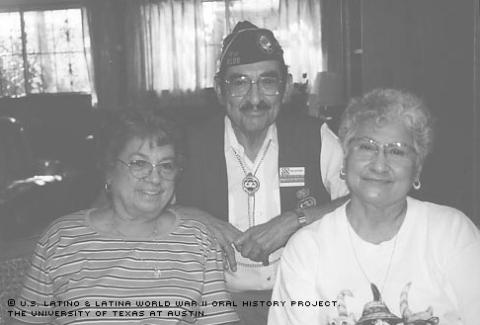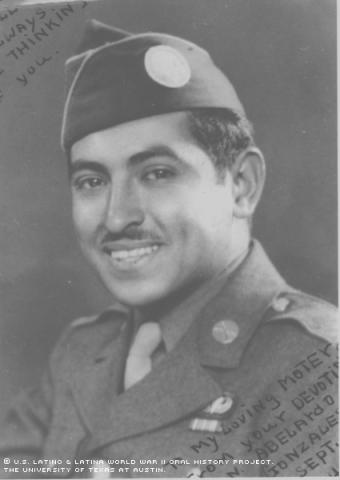

By Trinidad Aguirre
A paratrooper and medical corpsman for the 507th Airborne Regiment, Abelardo M. Gonzales fought in World War II using bandages instead of bullets, tourniquets instead of bayonets.
Gonzales recalled his combat experiences while at the southside San Antonio home of his sister, Georgina.
"My first jump was at night, Normandy 1944. It was too dark, too cloudy, so we were scattered landing all over the place," he said. "In a night jump, you have to strain your eyes to see the ground coming.
"Of all the places for me to land, I end up landing on my knees on the only paved road for miles around. Both of my knees were injured. I couldn't walk."
That night Gonzales made his way, with both knees swollen to the size of cantaloupes, to a farmhouse along with other soldiers. He cared for the wounded as best he could.
The morning sun found Gonzales peeking through the front door keyhole, watching German tanks and troops rushing past, ignoring the farmhouse as they headed into battle.
Twenty-four hours later, the Germans passed by again, this time in retreat. Only this time, the Germans stopped at the farmhouse. Gonzales and his fellow soldiers were now prisoners of war.
"The Germans came in, saw we were in bad shape and put a guard at the front door," Gonzales remembered. "A couple of days later, I woke up and the guard was gone!"
Gonzales and the others soon found themselves liberated, loaded onto the back of some U.S. tanks, and en route to a hospital in England.
One full-length leg cast, a mended broken kneecap and a few weeks of bicycling around the hospital grounds later, Gonzales returned to the 507th. After three weeks of much-deserved rest at London's Piccadilly Circus, he rejoined his unit, just as the 507th was moving out to the front lines, along with the 82d, 101st and 17th Airborne Divisions. The three divisions were getting trucked, instead of parachuted, in a daring military maneuver to stop the advancing German tank offensive. If the paratroopers failed, it would be disastrous for the Allied forces.
"Three divisions, they put them right in front of the advancing Germans," Gonzales recalled. "That's where they put the paratroopers. We stopped them there. They didn't go no further. That was the Battle of the Bulge."
In the preface of “Nuts: The Battle of the Bulge,” authors Donald M. Goldstein, Katherine V. Dillon and J. Michael Wenger, describe the battle as “a patchwork quilt – a multitude of small engagements played out in or near small towns, most of no military significance.” Despite this fact, the U.S. suffered approximately 81,000 casualties, including 19,000 killed; The British suffered around 1,400 casualties, including approximately 200 killed. Germany lost an estimated total of 100,000 -- dead, wounded and captured. Image after image in Nuts is dominated by snow and rubble, complete destruction.
Gonzales’ combat medic role of mending the soldiers’ torn flesh so they might survive to fight another day, even if it meant having to perform the task in the middle of a firefight, was easier said than done. One can imagine him hearing the cry of "Medic!" and the whizzing enemy bullets and flying shards of jagged bomb shrapnel becoming a faint background hum as he runs forward to care for the wounded scattered on the battlefield.
Gonzales described his medic toolbox:
"I had a unit of plasma. At that time, the plasma, it was in the powder form," he said, "Then they had the sterile water in another container. You had to mix them together before you gave them to a patient. ... And I tied a lot of bandages to my legs. Also, they gave you a lot of morphine to give to the wounded. Just as soon as they called 'Medic!' you go out there, you see he is wounded, you give him a shot of morphine to kill the pain."
Gonzales recalled sticking the wounded soldier's rifle in the ground and placing his helmet on top of it to mark where a wounded soldier lay.
After three bitterly cold months on the front lines, the 507th and 17th divisions were sent to France.
Their rest in France was short-lived, and on March 24, 1944, Gonzales and the men of the 507th took to the skies.
This time, it would be a day jump over the Rhine River. The paratroopers could see where they were landing, but they would also be visible to the enemy.
"I jumped out and all around me I could see many airplanes, dropping hundreds of soldiers. We filled the sky with parachutes," he said. "I also saw the white puffs of smoke as the anti-aircraft rounds exploded in the air around us."
Gonzales said the paratroopers pretended to be dead in the hopes that the Germans wouldn't shoot at them.
"Up there, there is no place to hide and only one direction to go," he said. "And if you hit the ground alive, well then you have a fighting chance at survival."
Gonzales survived that battle and the war would end a few months later.
He eventually returned to San Antonio to his mother, three sisters and a civil service job at Fort Sam Houston, which he'd left when he was drafted.
Perhaps Gonzales' service as a medic stemmed from his days as a provider for his family.
His baby sister, Amparo, recalled a time when her brother helped heal her injuries.
"Our dad left us when we were little, so really, it was Abelardo who always took care of us," she said. "I remember one time when we were kids, I was playing in a ditch ... and I cut the heel of my foot wide open. Abelardo took me inside and put a corn poultice on my foot. It hardened like a cast."
Amparo said she spent many days waiting on the porch for her brother to return.
"We knew he was coming home, just not when" she said. "I saw him first. He had his duffle bag over his shoulder and the sun was behind him. I yelled, letting everyone know Abelardo was home. I then ran up to him and hugged him. Oh, I was so happy he made it home."
Gonzales, now retired, continues to care for his fallen comrades. He recently earned an award from the Audie Murphy Army Hospital for having given more than 2,000 volunteer hours as a member of the Fort Sam Houston National Cemetery Memorial Service Detachment. The detachment is a volunteer organization dedicated to providing a burial with full military honors for all veterans.
The practice was once paid for by the government. Now, however, only certain people retain that privilege.
This is why Gonzales and his fellow veterans volunteer their services.
On any given Tuesday, Gonzales can be found at the Fort Sam Houston National Cemetery, standing tall in his honor guard uniform.
"The government stopped funding proper funerals for veterans," he said. "No honor guard, no gun salute, nada. We want to do more."
Mr. Gonzales was interviewed in San Antonio, Texas, on September 8, 2000, by Trinidad Aguirre.

